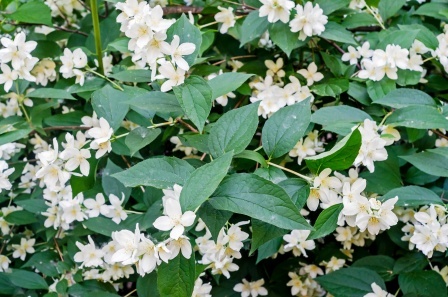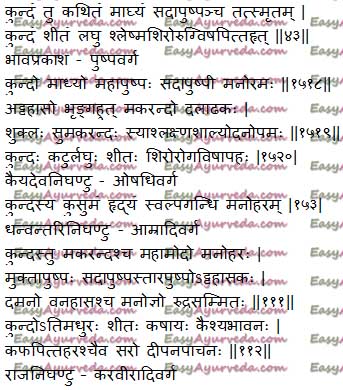Kunda (Jasminum multiflorum) – Uses, Remedies, Medicinal Qualities

By Dr Renita D’Souza
Kunda is a variety of jasmine plant known for its fragrant white flowers. Kund flowers, as it is pleasant to see is also considered as coolant to the body. This aromatic Ayurvedic herb is used in the treatment of headache, wound, poisoning etc.
Table of Contents
Remedies, qualities, uses
Traditional Remedies of kund
- Poultice of kund leaves are applied over the wounds. It hastens the wound healing process.
- Roots are made used in snake poisoning
- In Asthma, kundam flowers along with long pepper is given to drink with rice washed water (tandulodaka).
Read – Jasmine – Chameli: Benefits, Remedies, Research, Side Effects
Botanical Name – Jasminum multiflorum
Family – Oleaceae
Synonyms – Jasminum pubescens, Jasminum gracillimum, Mogorium multiflorum
Medicinal qualities
Taste – Pungent -K.N; Sweet, astringent – R.N
Virya (potency) – cold (shita)
Qualities –
Laghu – light to digest
Effect on Tridoshas
Balances Kapha and Pitta dosha
Indications
Shiroroga – Headache
Visha – poisoning, toxic conditions

Kunda Flowers
Shukla – white
Hrdya – good for heart
Swalpa gandhi – mild aromatic
Manoharam – emits pleasant smell
Flowers are borne in clusters and when the plant flowers it covers all leaves so whole plant appears white. In Indian mythology, Kund is known for its whiteness. In Indian tradition, kunda flowers are used in worship and marriage ceremony.
Read – Nav mallika (Jasminum arborescens) – Uses, Qualities, Side Effects
Part Used
Flowers, leaves, roots
Distribution, morphology, verse
Distribution
Jasminum multiflorum is found in India, Nepal, Bhutan, Laos, Burma, Thailand and Vietnam
Morphology
Jasminum multiflorum is climbing shrub reaches to a height of 8 to 10 feet. Leaves are ovate, evergreen, opposite, simple, 5 – 6 cm long. Minute hairs on leaves and stem gives the plant greyish green appearance. Flowers are white.

Interaction with medicines, supplements
Can this be used while taking Homeopathic medicine?
Yes. This product does not react with homeopathic medicine.
Can
this medicine be continued while taking supplements like multivitamin tablets,
Omega 3 fatty acids etc?
Yes. Generally, this product goes well with most
of the dietary supplements. However, if you are taking more than one product
per day, please consult your doctor for an opinion.
With western
medicines
Seek your
doctor’s advice if you are taking this product along with other western
(allopathic / modern) medicines. Some Ayurvedic herbs can interact with modern
medicine.
If both Ayurvedic and allopathic medicines are advised together, then it is
best to take Allopathic medicine first, wait for 30 minutes and then take the
Ayurvedic medicine.
Synonyms, category
Names of Kunda in different languages
English Name – Winter jasmine, Indian jasmine, Downy jasmine, Star jasmine
Tamil Name – Kasturi-mallikai, Makaranta-mallikai
Telugu Name – Kundamu, Molla
Bengali Name – Chameli, Kundo, Kunda
Hindi Name – Ban malati, Kunda, Palind, Daladhak, Dal-kosh, Jangali chameli
Kannada Name – Dodda kaadu mallige, Kasturi mallige, Maagi mallige Konkani Name – Ran mogre
Malayalam Name – Kundam, Kuruna
Gujarati Name – Mogro
Manipuri Name – Kundo
Marathi Name – Kunda, Ran mogra
Oriya Name – Dala kosha, Danta patraka, Kunda,Maghya,Tapasya
Read – Yuthika Jasminum auriculatum: Benefits, Remedies, Research, Side Effects
Sanskrit synonyms
Maadhya, Sadapushpa
Mahapushpa, Manorama
Aatahasaka, Makaranda
Daladaka
Classical categorisation
Bhavaprakkasha Nighantu – Pushpa Varga
Kaiyadeva Nighantu – AushadiVarga
Dhanvantari Nighantu – Aamradi Varga
Raja Nighantu – Karaviradi varga
Click to Consult Dr Renita D’Souza










